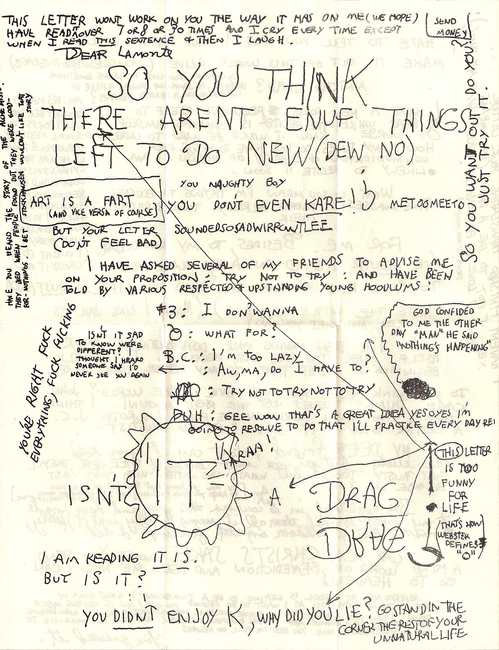Anyone remember this?
This is the submission under the name “Dennis” in the 1963 book An Anthology edited by La Monte Young and Jackson Mac Low, and of course it’s Dennis Johnson. (Sorry, I have an obsessive personality, and right now the latest of many, many obsessions is Dennis Johnson. Next up: Robert Ashley.) You may recall the book as a collection of outrageous avant-garde gestures and essays (I saw a copy on sale at Dia Beacon recently with a hefty price tag), and this letter from Dennis came as a loose piece of paper in an envelope pasted on one of the pages. I bought the book when I was in high school, probably 1970 or ’71, and have guarded my copy carefully for four decades. I didn’t instantly connect “Dennis” with Johnson, but the all-caps handwriting is identical to that on the score to November. Also, Young mentioned in his semi-famous “Lecture 1960” that Johnson had written him, in response to a famous Cage story, that “THERE’S TOO MUCH WORLD IN THE EVIL,” and that line comes from the back of this document. The envelope bears a postmark of March 11, 1960, and Dennis mentions on the back that he’s 21, which, assuming it’s not a joke, places his birthdate at 1938 or ’39 – the first mention I’ve seen of his age. He doesn’t have an entry in Grove, nor even in Wikipedia.
There are other references to Cage. “SOUNDED SO SADWIRROWTLEE” is doubtless a reference to a satire of Japanese poetry Cage included in Silence (1960). In the upper lefthand corner is a rather insulting reference to Stockhausen, and on the back Dennis mentions a desire to spit at Stockhausen (“YOU SEE I’M FULL OF DESIRES”). La Monte went to Darmstadt in 1959, and somewhere he mentions that Johnson was going to accompany him, but caught pneumonia and had to stay in New York with electronic composer Richard Maxfield, so he had already missed getting his wish. In March 1960, Terry Jennings was 19, La Monte 24, and Dennis apparently 21, and their lives clearly revolved around Cage and Stockhausen, with a curious mixture of attraction and antipathy for the two of them. La Monte had written his Trio for Strings in 1958, and, inspired by that, Johnson wrote November the following year. Later in 1960 La Monte started his avant-garde series in Yoko Ono’s loft, and Downtown music was born.Â
This silly letter has stuck in my mind since I was younger than the brash avant-gardist who penned it, and it’s funny to think that 40 years later I would become so involved with the work of this irreverent youngster. I’m in love with November; I’m in the process of making my own four-hour recording of it, so I’ve been listening to it at home as music, and not just as a tape-hissy historical document with a dog barking in the background. (My dog Gita, named for the woman who taught Cage about Indian philosophy, responds in kind whenever the dog appears.) Forgive me for being so coy with the results, but I don’t want to steal too much thunder from our premiere at the minimalism conference. Give me a couple of months, and you’ll hear more about November, and the guy who wrote the above letter, than you ever thought you’d learn. Meanwhile, I’m all caught up in the mindset in which minimalism was born: not the Famous Four minimalists, but the pre-famous three from California, Johnson, Jennings, and Young.

